Deck fascia boards serve as essential finishing elements that transform ordinary deck structures into polished outdoor living spaces. These horizontal trim pieces cover exposed rim joists and deck board ends, creating clean lines while protecting structural components from moisture and pests. Beyond their functional role, fascia boards offer unlimited design possibilities through material choices, color contrasts, and integrated features. From traditional wood applications to modern composite solutions, deck fascia can dramatically enhance your outdoor space's visual appeal. Whether you prefer subtle matching tones or bold contrasting accents, the right fascia design elevates your deck from basic platform to sophisticated architectural feature.

1. Classic Cedar Fascia with Natural Finish
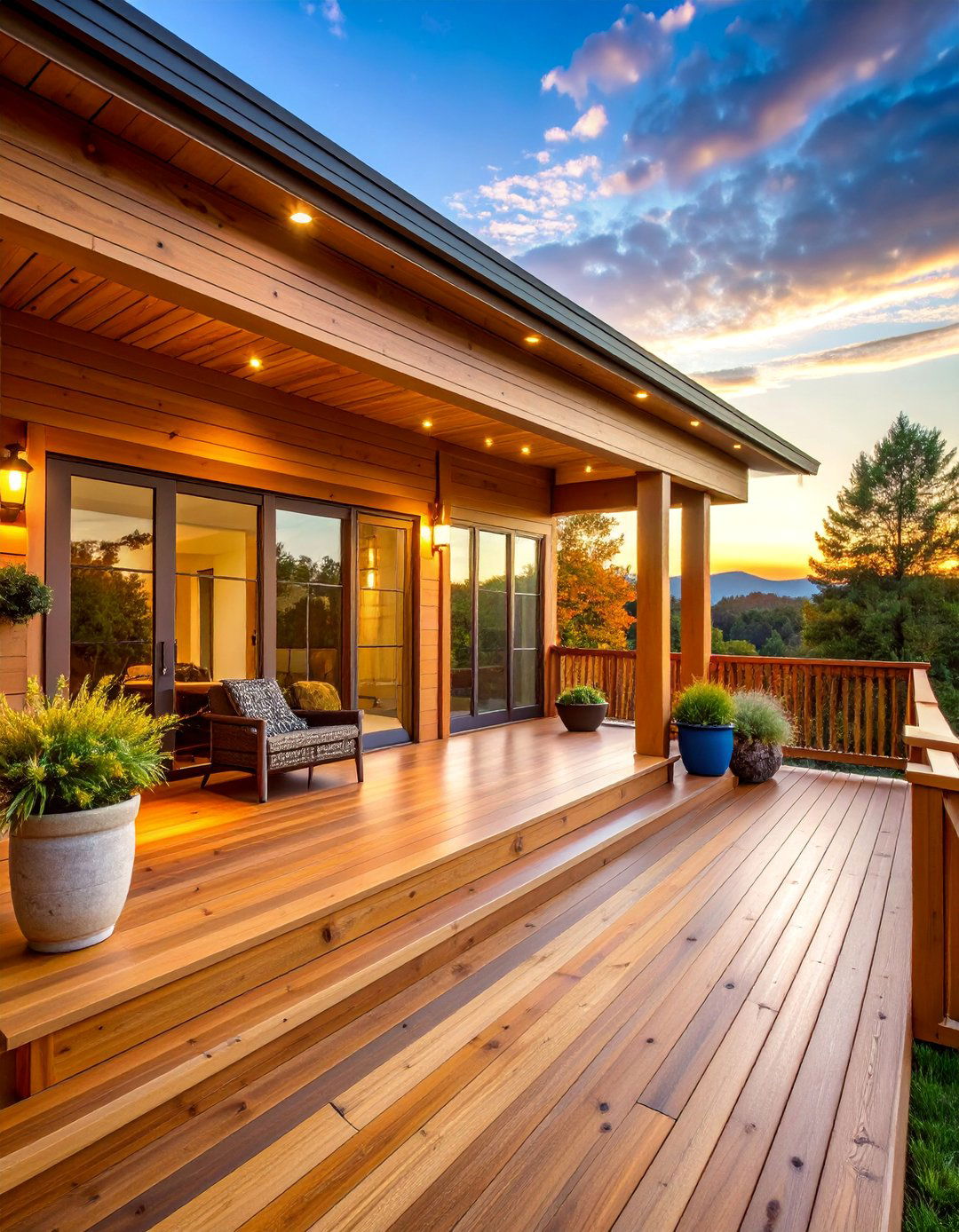
Cedar fascia boards bring timeless warmth and natural beauty to any deck design. This traditional approach showcases cedar's distinctive grain patterns and rich, honey-colored tones that complement both rustic and contemporary home styles. The natural oils in cedar provide inherent resistance to rot, decay, and insect damage, making it an excellent long-term investment. For optimal performance, apply a clear penetrating stain or sealant to enhance the wood's natural color while providing additional weather protection. Cedar fascia pairs beautifully with matching deck boards or creates striking contrast against composite surfaces. Regular maintenance every two to three years ensures lasting beauty and structural integrity for decades.
2. Composite Fascia Picture Frame Design

Composite fascia creates a sophisticated picture frame effect by running matching boards around the deck's entire perimeter. This design technique uses composite materials that resist fading, staining, and moisture damage while maintaining consistent color throughout changing seasons. The picture frame approach adds architectural definition and visual interest without overwhelming other design elements. Choose composite fascia in colors that either match your decking for seamless integration or contrast dramatically for bold definition. The low-maintenance nature of composite materials eliminates the need for regular staining or painting, making this an ideal choice for busy homeowners. Professional installation ensures proper expansion gaps and secure fastening for optimal performance.
3. Contrasting Dark and Light Fascia Combination

Create dramatic visual impact by combining dark and light fascia boards in strategic arrangements. This bold design approach uses contrasting colors to define different deck levels, highlight architectural features, or separate functional zones within your outdoor space. Consider pairing charcoal composite fascia with white PVC trim for modern sophistication, or combine rich mahogany stain with natural cedar tones for rustic elegance. The contrast technique works exceptionally well on multi-level decks where different fascia colors can distinguish between upper and lower platforms. Careful planning ensures color transitions appear intentional and balanced, creating a custom appearance that reflects your personal style while enhancing your home's overall curb appeal.
4. Integrated LED Strip Lighting Fascia
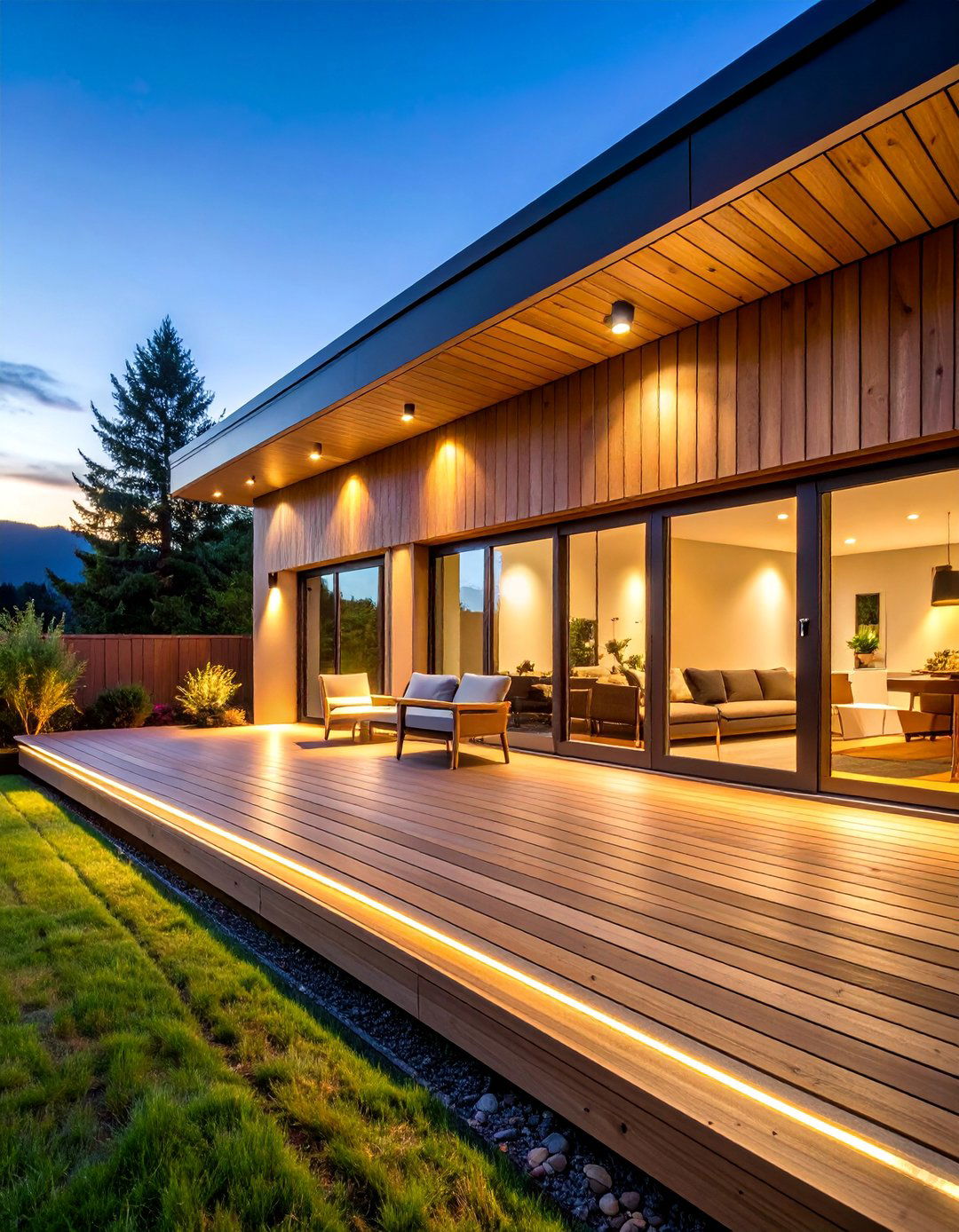
Transform evening entertaining with fascia boards featuring integrated LED strip lighting systems. This innovative design incorporates weather-resistant LED strips into specially designed fascia channels, creating ambient illumination that enhances safety and atmosphere. The lighting follows your deck's perimeter, providing gentle guidance along edges while highlighting architectural details. Choose warm white LEDs for cozy ambiance or color-changing strips for festive occasions. The integrated approach eliminates visible wiring and creates clean, professional-looking installations. Low-voltage LED systems operate efficiently and safely, with many options featuring smart controls for customizable brightness and timing. This sophisticated lighting solution adds significant value while extending your deck's usable hours into the evening.
5. Vertical Board and Batten Fascia Style
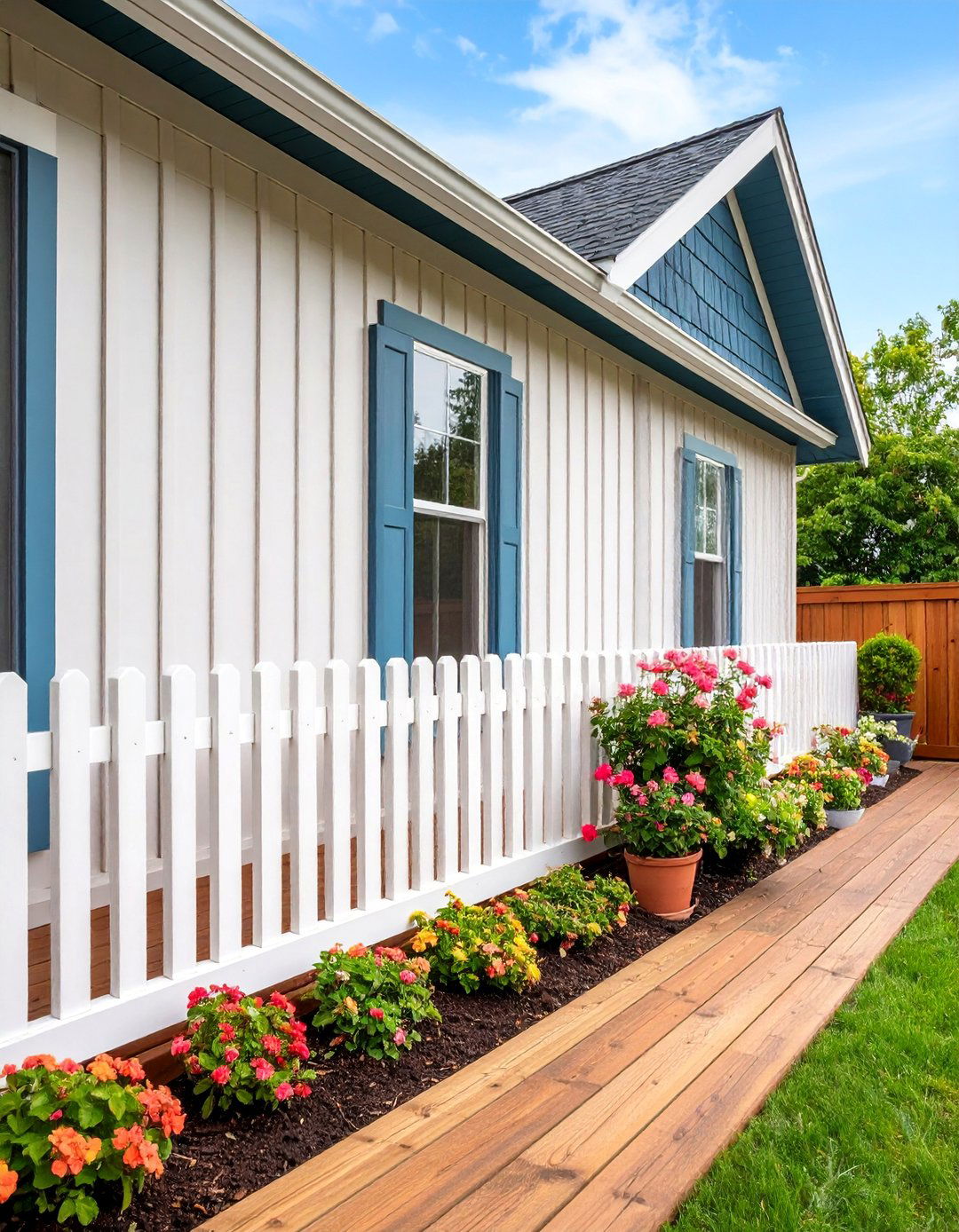
Vertical board and batten fascia creates farmhouse charm with contemporary functionality. This design features closely spaced vertical boards that cover rim joists while adding texture and visual height to your deck's profile. The vertical orientation draws the eye upward, making your deck appear taller and more substantial. Traditional board and batten spacing uses narrow battens over wider boards, creating shadow lines that add depth and dimension. Modern interpretations may use uniform board widths for cleaner lines. This style works exceptionally well with composite or PVC materials that maintain crisp edges and consistent spacing. The vertical design also helps shed water more effectively than horizontal installations.
6. Mixed Material Fascia with Stone Veneer Base

Combine natural stone veneer with wood or composite fascia for sophisticated material mixing that creates visual weight and permanence. This design places stone veneer on the lower portion of the fascia area, topped with matching deck board material for seamless integration. The stone base provides excellent moisture protection while adding texture and color variation. Choose from natural fieldstone, cultured stone, or modern concrete panels depending on your aesthetic preferences. The mixed material approach works particularly well on elevated decks where the extended fascia height creates opportunities for creative material combinations. Professional installation ensures proper moisture barriers and structural support for long-lasting beauty.
7. Horizontal Slat Fascia with Spacing Gaps
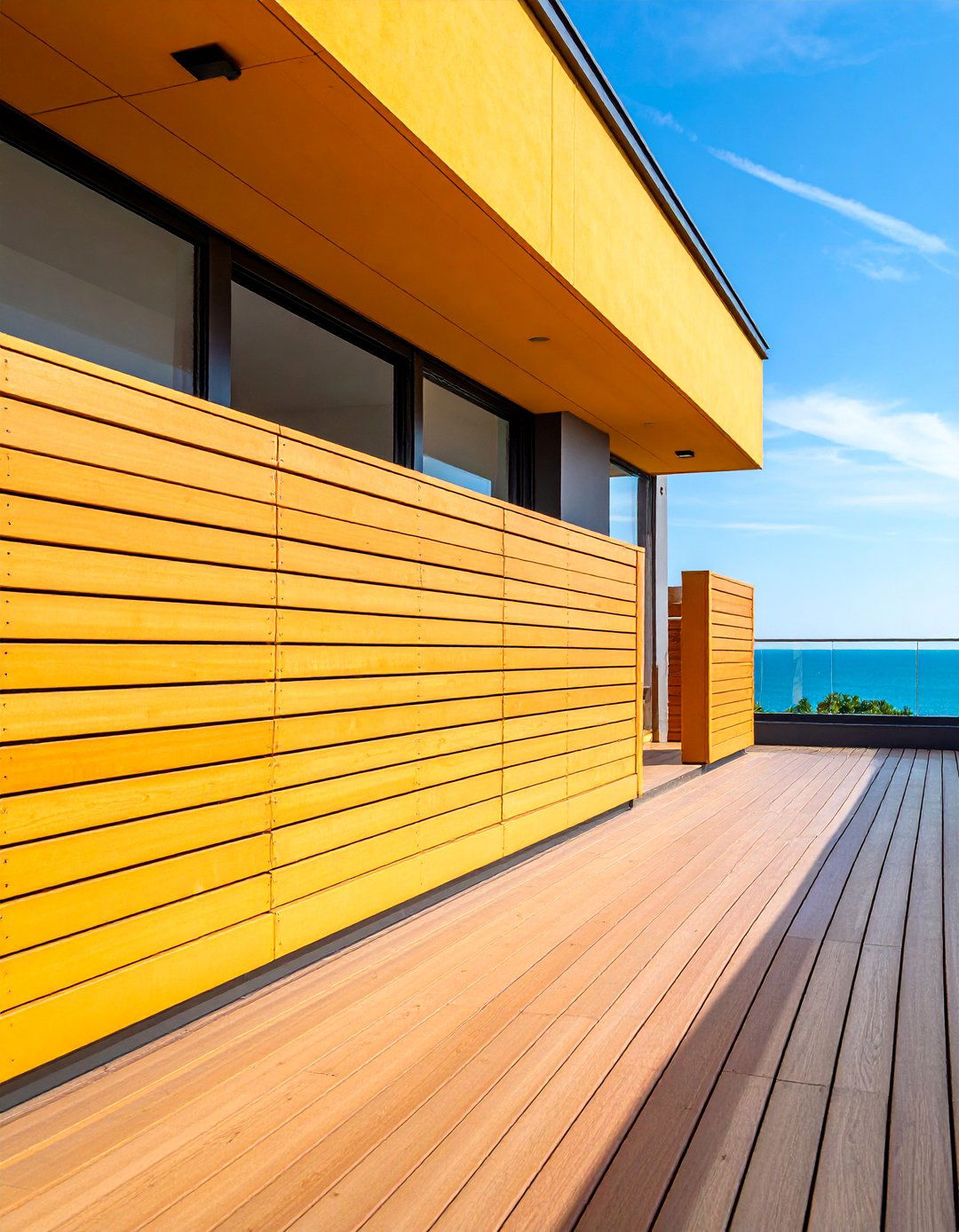
Contemporary horizontal slat fascia features evenly spaced boards with gaps between each piece, creating modern visual interest while promoting air circulation. This design approach uses consistent spacing throughout the installation, typically ranging from half-inch to two-inch gaps depending on the desired aesthetic. The gaps prevent moisture buildup while adding shadow lines that enhance the fascia's dimensional appearance. Choose composite or PVC materials for consistent gap spacing and long-term durability. The horizontal orientation complements modern architectural styles and works exceptionally well with metal railings and clean-lined deck furniture. Hidden fastening systems maintain the clean appearance while ensuring secure installation that withstands weather extremes.
8. Curved Fascia for Rounded Deck Edges
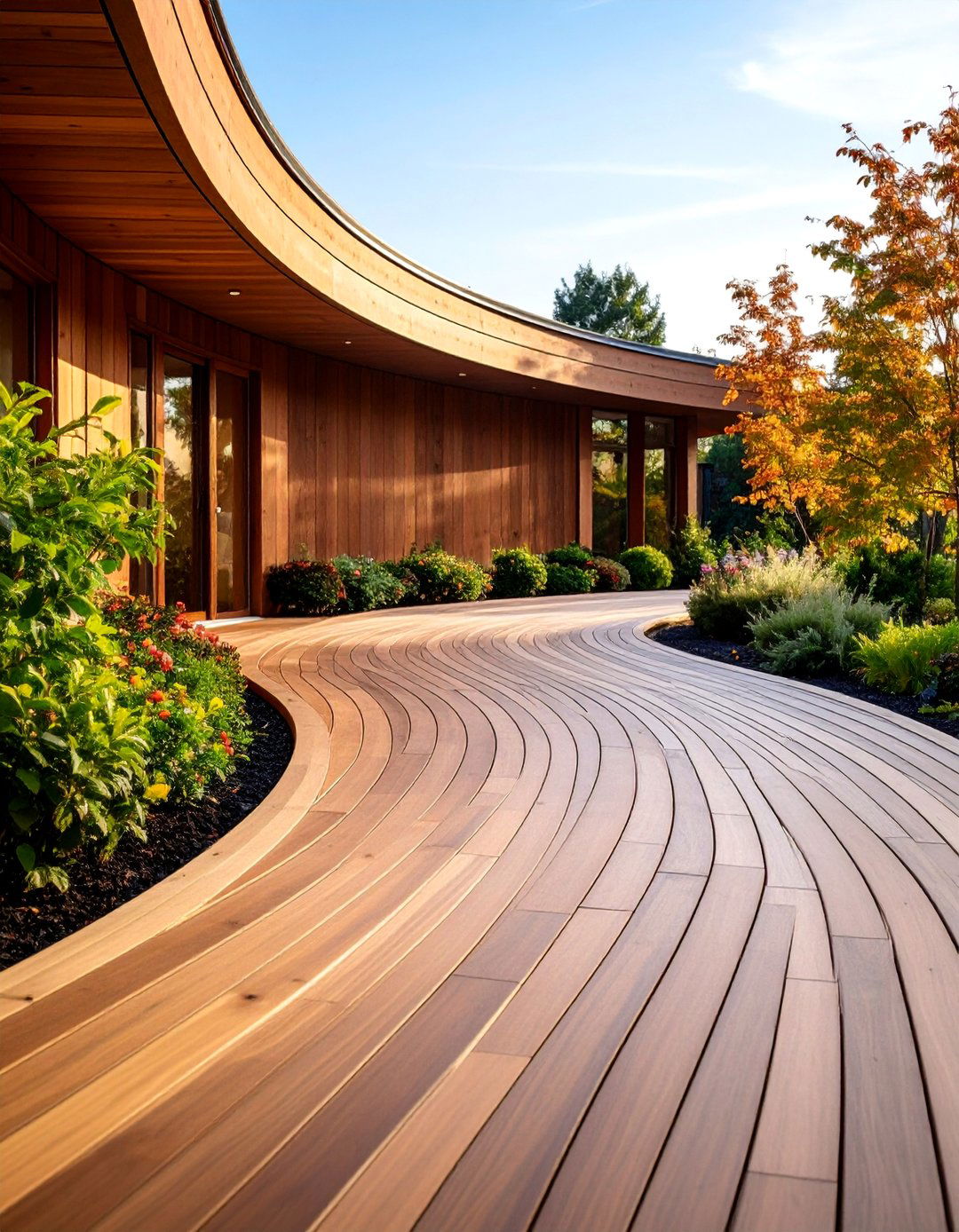
Curved fascia boards follow the rounded edges of curved decks, creating seamless transitions that enhance your deck's flowing design. This specialized application requires careful planning and skilled installation to achieve smooth curves that match your deck's profile exactly. Flexible composite materials or specially bent wood boards create the curved profile while maintaining structural integrity. The curved fascia technique works particularly well on decks with rounded corners, bay areas, or completely circular designs. Steam-bent wood offers traditional craftsmanship appeal, while flexible composite products provide modern convenience and durability. Professional installation ensures proper radius calculations and secure fastening that maintains the curve over time while protecting against moisture infiltration.
9. Two-Tone Fascia with Accent Trim
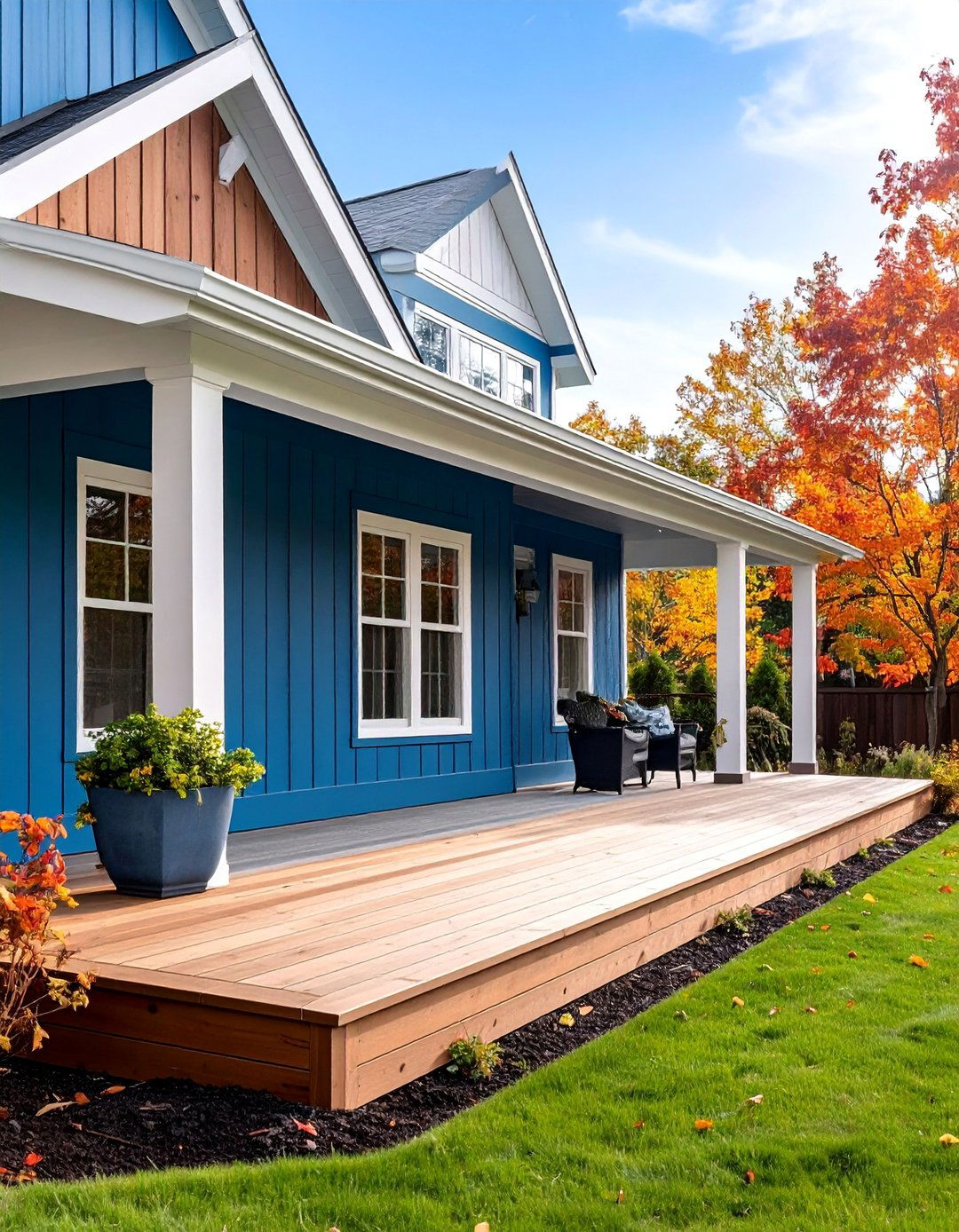
Two-tone fascia designs combine complementary colors to create sophisticated visual layers that enhance your deck's architectural appeal. This approach typically uses a primary fascia color matched to your decking, accented with contrasting trim pieces that highlight edges and joints. The accent trim can define the top edge, create horizontal divisions, or outline special features like built-in planters or storage areas. Choose colors that complement your home's exterior palette while providing enough contrast to define the design elements clearly. This technique works exceptionally well with composite materials that offer consistent colors and clean edges. The two-tone approach adds custom appearance without significantly increasing material costs.
10. Built-in Planter Box Fascia Integration

Integrate planter boxes directly into your fascia design for seamless garden integration that enhances both form and function. This approach builds planter boxes as extensions of the fascia system, using matching materials and consistent design elements for unified appearance. The planters can run along portions of the deck perimeter or create focal points at corners and entry areas. Proper drainage systems prevent water damage while ensuring healthy plant growth. Choose plants that complement your deck's exposure and maintenance preferences. The integrated planter approach softens hard deck edges while adding color and natural elements. Professional design ensures proper structural support and moisture management for long-lasting installations.
11. Aluminum Fascia with Powder Coat Finish
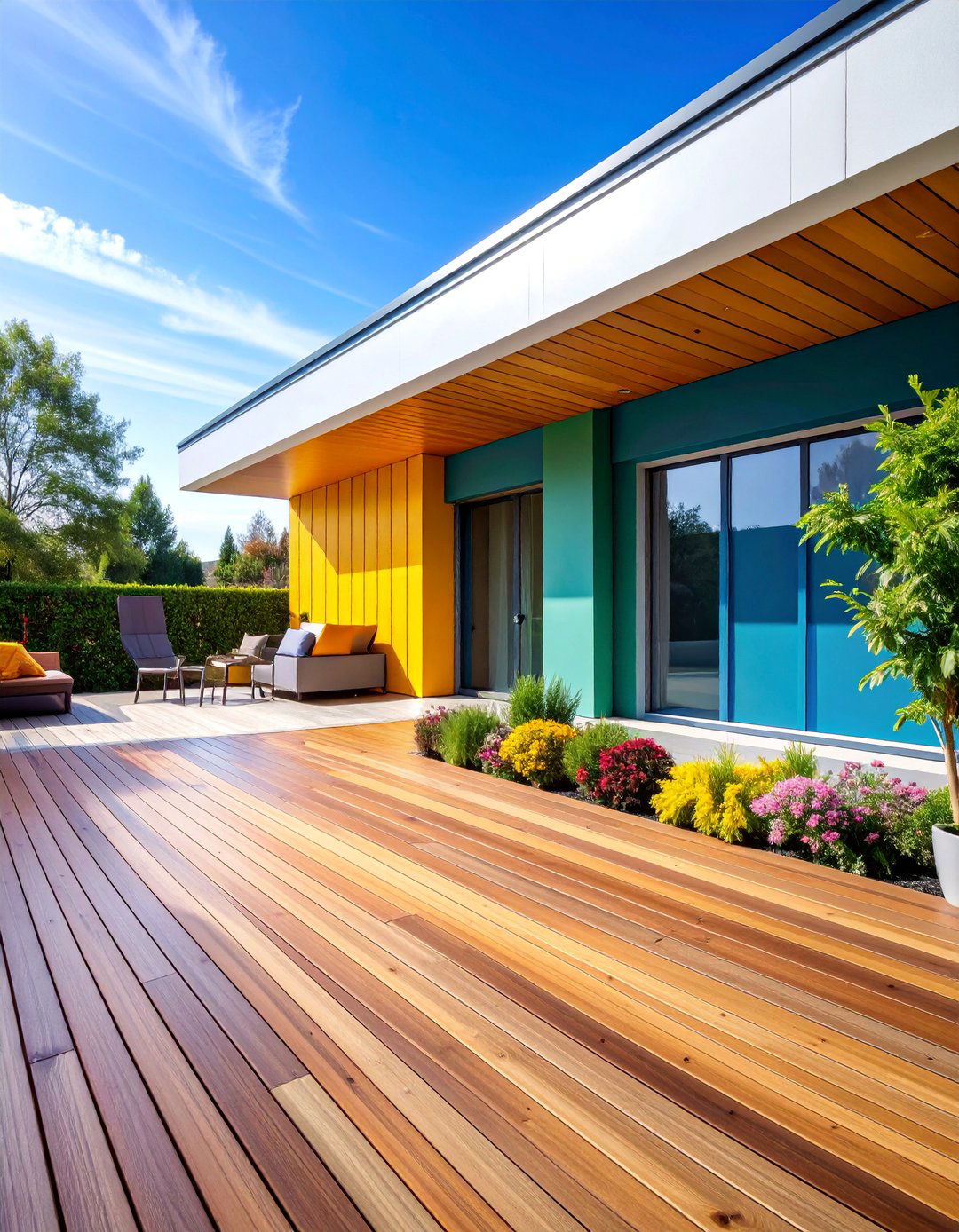
Aluminum fascia offers exceptional durability and modern aesthetics with powder coat finishes available in numerous colors and textures. This low-maintenance option resists corrosion, fading, and impact damage while maintaining crisp edges and consistent appearance for decades. Powder coat finishes provide superior color retention compared to painted surfaces, with options ranging from traditional whites and blacks to contemporary metallic and textured finishes. Aluminum fascia installs easily with standard fasteners and requires minimal maintenance beyond occasional cleaning. The material's lightweight nature simplifies installation while providing excellent strength-to-weight ratios. This option works particularly well in coastal environments where salt air challenges traditional materials, offering long-term performance and visual appeal.
12. Reclaimed Wood Fascia with Rustic Character

Reclaimed wood fascia brings authentic character and environmental responsibility to your deck design. This approach uses salvaged barn wood, old fence boards, or other weathered lumber to create fascia with genuine aging and patina that new materials cannot replicate. Each piece tells a story through natural weathering patterns, nail holes, and color variations that add unique personality to your outdoor space. Proper treatment and sealing preserve the rustic appearance while providing necessary weather protection. The reclaimed approach works exceptionally well with farmhouse, industrial, and eclectic design styles. Source reclaimed materials from reputable suppliers who ensure proper preparation and treatment for outdoor applications requiring structural integrity and longevity.
13. Fiber Cement Fascia with Architectural Details

Fiber cement fascia provides exceptional durability with architectural styling options that enhance your deck's sophisticated appearance. This composite material combines cement, sand, and cellulose fibers to create boards that resist fire, moisture, and insects while accepting paint and stain finishes beautifully. The material can be milled with decorative profiles, beaded edges, or other architectural details that add visual interest without requiring complex installation techniques. Fiber cement maintains consistent dimensions and crisp details over time, making it ideal for formal deck designs that require precise appearance. The material's paintability allows for color changes over time, providing design flexibility that accommodates evolving preferences. Professional installation ensures proper fastening and sealing for optimal performance.
14. Multi-Level Stepped Fascia Design

Multi-level stepped fascia creates dramatic visual impact by varying the fascia depth at different levels or sections of your deck. This approach uses progressively deeper fascia boards to create a stepped profile that adds architectural interest and shadow lines. The stepping technique can follow deck level changes, define seating areas, or create focal points at key locations. Each step requires careful planning to ensure proper proportion and structural support. The multi-level approach works particularly well with contemporary and modern architectural styles that emphasize geometric forms and clean lines. Use contrasting colors or materials to emphasize the stepping effect, or maintain consistent colors for subtle dimensional interest.
15. Glass Panel Insert Fascia System
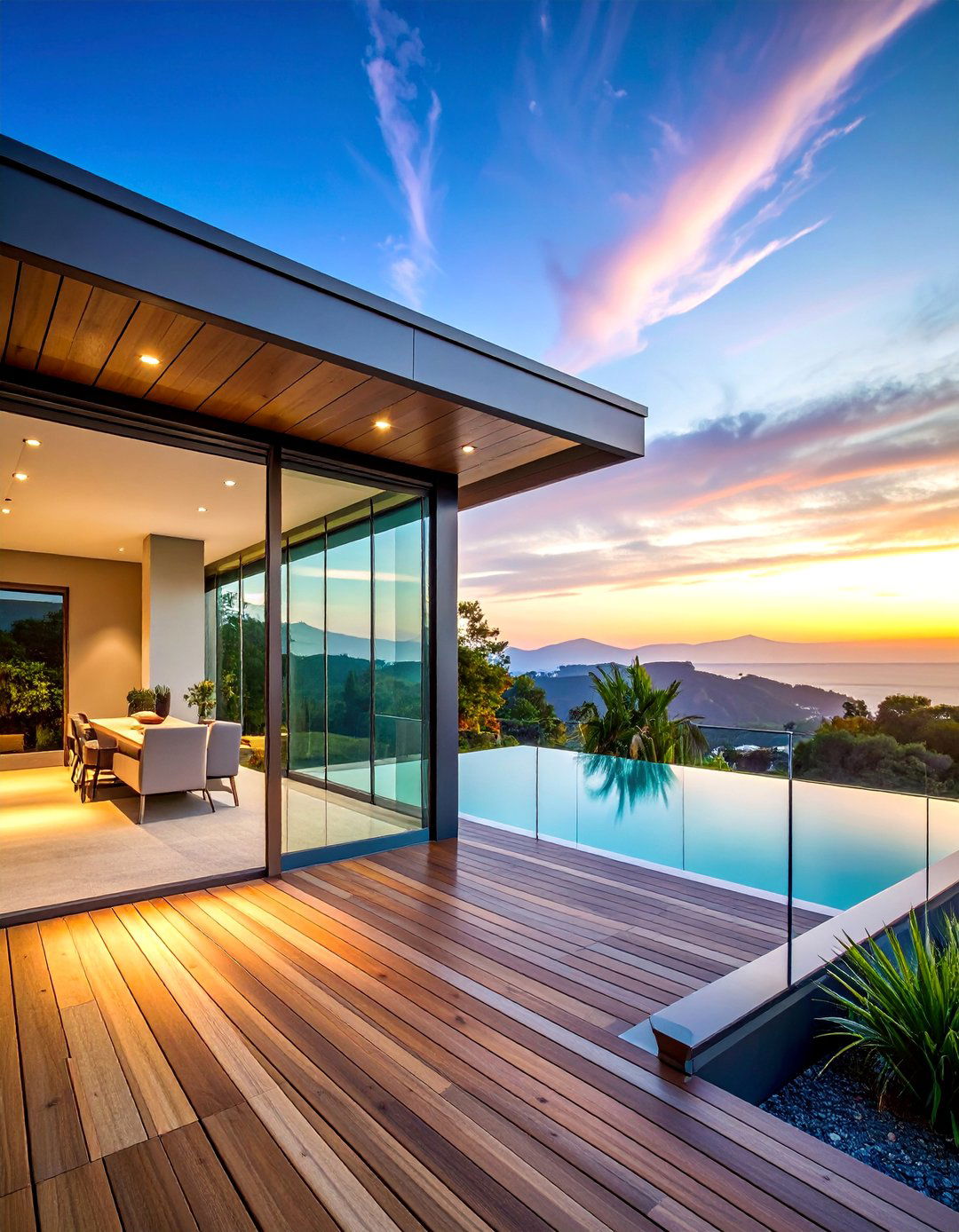
Glass panel inserts within fascia framing create modern transparency that maintains open sight lines while providing wind protection. This sophisticated approach uses structural fascia framing to support tempered glass panels that can be clear, frosted, or tinted depending on privacy and aesthetic preferences. The glass panels reflect natural light and surrounding landscape elements while creating visual continuity between deck and yard areas. Safety glass requirements ensure impact resistance and proper breakage patterns for outdoor applications. The glass insert system works exceptionally well on elevated decks where wind protection enhances comfort without blocking views. Professional installation ensures proper glazing and structural support for long-term safety and performance.
16. Diagonal Pattern Composite Fascia
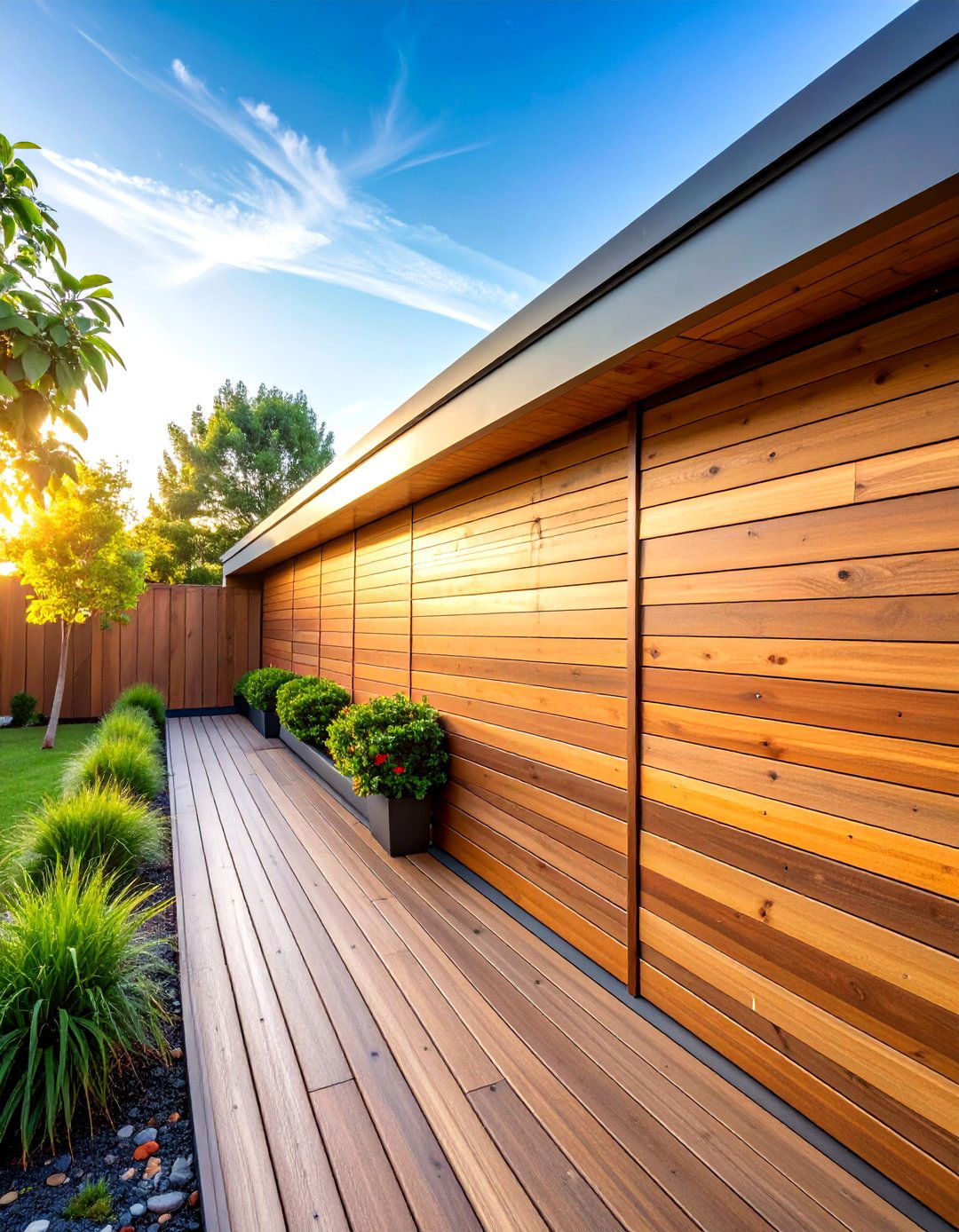
Diagonal composite fascia creates dynamic visual movement that complements angled deck board patterns while adding contemporary flair. This approach installs fascia boards at consistent angles, typically 45 degrees, creating chevron or herringbone patterns that draw attention and add personality. The diagonal installation requires precise cutting and planning to ensure consistent angles and proper joint alignment. Choose composite materials with clean edges and consistent colors to emphasize the geometric pattern effectively. The diagonal approach works particularly well as accent elements on portions of the fascia rather than entire perimeter installations. This technique pairs beautifully with modern railings and minimalist deck furniture that echo the clean geometric lines.
17. Integrated Storage Compartment Fascia

Storage compartment fascia combines functionality with finished appearance by incorporating hidden storage spaces within the fascia structure. This approach builds deeper fascia sections that include access panels for storing deck accessories, pool supplies, or seasonal items. The storage compartments maintain the fascia's clean exterior appearance while providing convenient access through hinged panels or sliding doors. Proper moisture protection ensures stored items remain dry while ventilation prevents condensation buildup. The integrated storage approach works particularly well on large decks where perimeter storage reduces clutter while maintaining organized outdoor spaces. Choose hardware that complements your deck's overall design while providing reliable access and security for stored items.
18. Traditional White PVC Fascia with Raised Panels
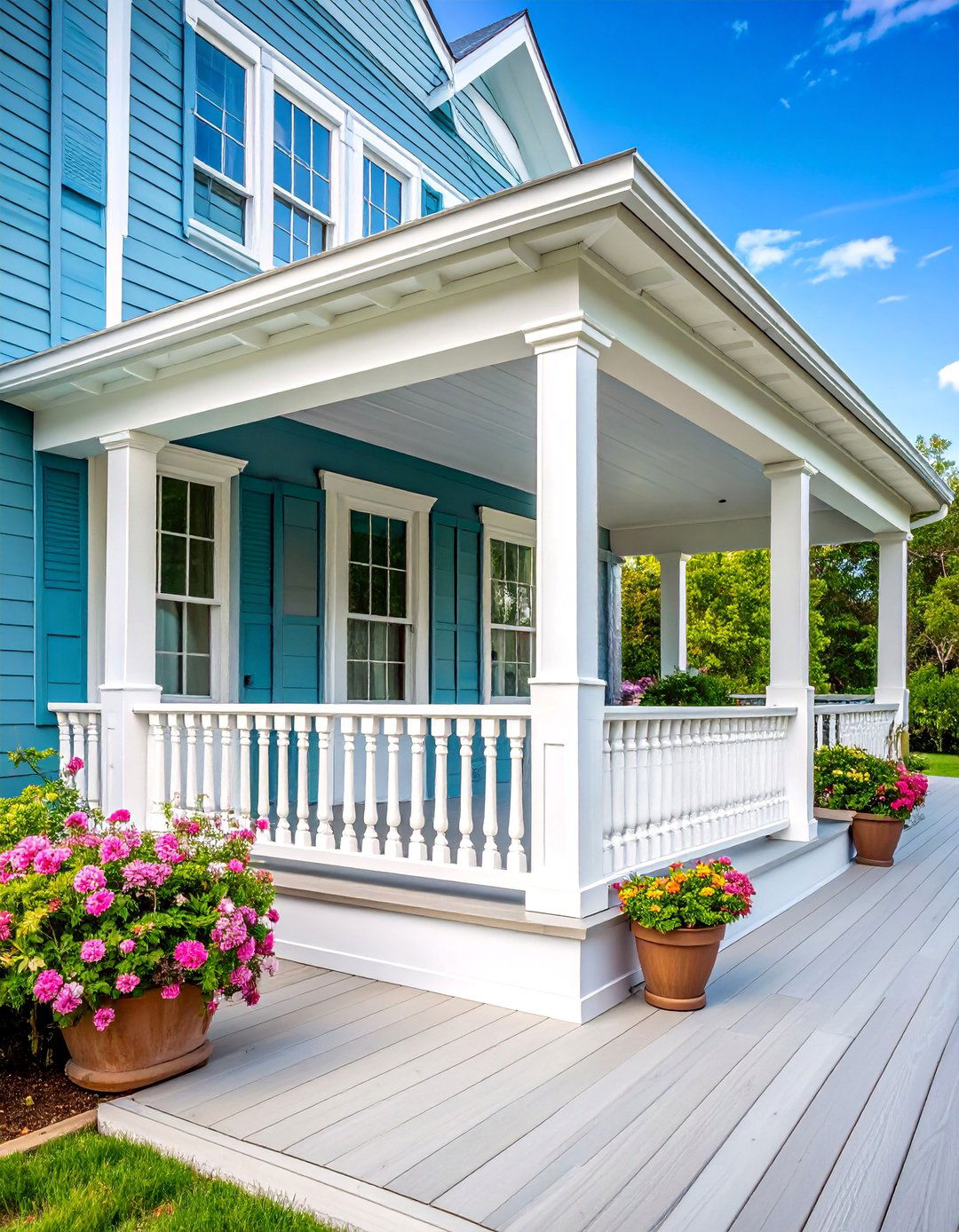
Traditional white PVC fascia with raised panel details brings classic architectural elegance to any deck design. This approach uses specially formed PVC boards that include raised rectangular panels separated by stile and rail details, mimicking traditional millwork patterns. The bright white finish provides crisp contrast against natural deck colors while maintaining consistent appearance without painting or staining requirements. The raised panel design adds depth and shadow lines that enhance visual interest and architectural authenticity. PVC materials resist moisture, insects, and UV damage while maintaining their crisp white appearance for decades. Professional installation ensures proper expansion allowances and secure fastening for optimal performance. This classic approach complements traditional and colonial architectural styles perfectly.
19. Live Edge Wood Fascia with Natural Bark
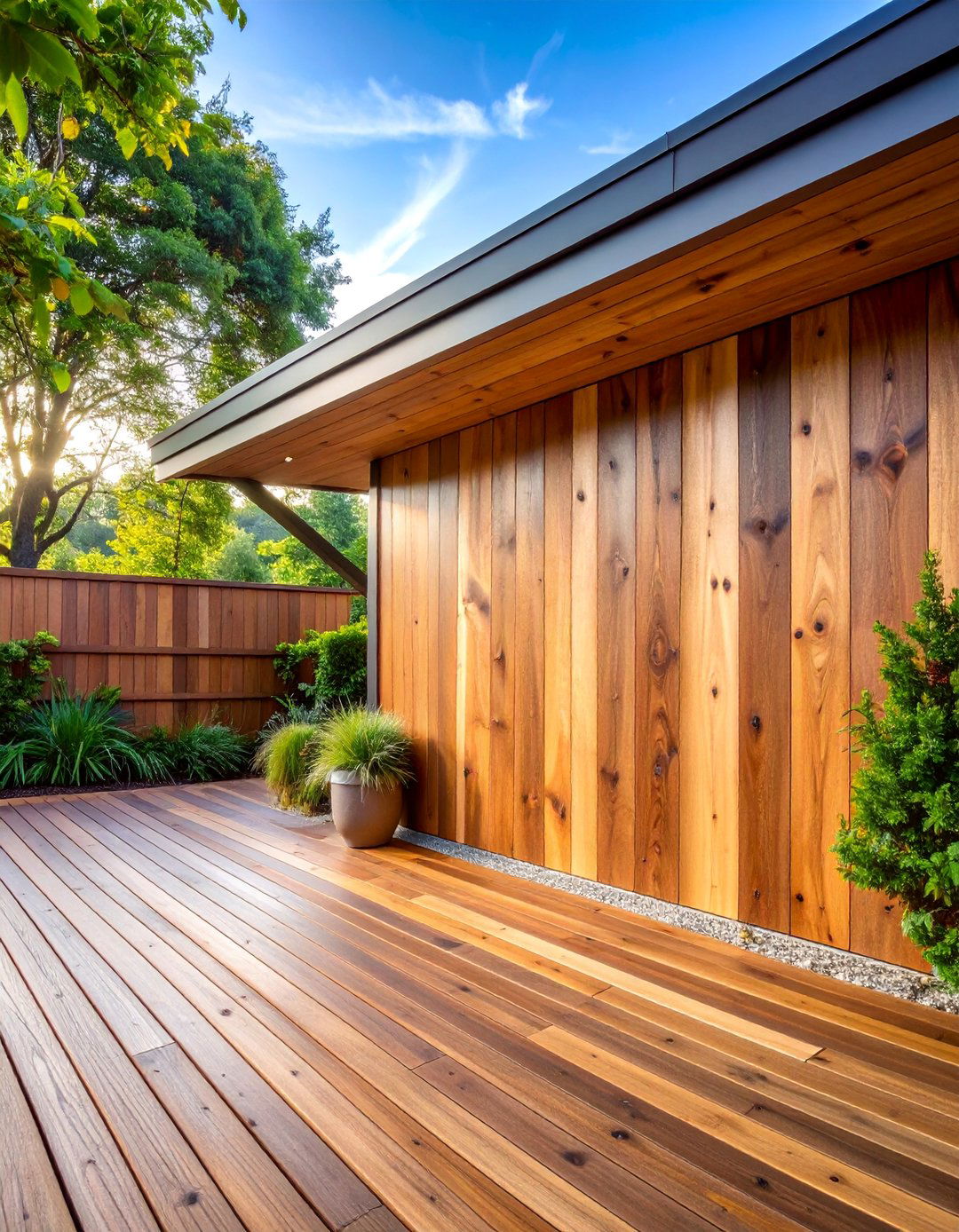
Live edge wood fascia preserves the natural bark edge for organic character that blends seamlessly with natural landscapes. This unique approach uses specially selected lumber that retains the tree's natural edge, creating fascia with irregular lines and authentic woodland character. The live edge technique works particularly well in rustic, cabin, or naturalistic settings where maintaining connection to natural materials enhances the overall design concept. Proper preparation and sealing preserve the bark while ensuring structural integrity and weather resistance. Each live edge piece offers unique character that cannot be replicated, creating truly custom installations. Source materials from sustainable forestry operations that provide properly dried and prepared lumber suitable for exterior applications requiring both beauty and durability.
20. Decorative Metal Screen Fascia Panels

Decorative metal screen panels create artistic fascia elements that combine functionality with striking visual appeal. This approach uses laser-cut, perforated, or expanded metal panels in various patterns ranging from geometric designs to nature-inspired motifs. The metal screens provide partial transparency while maintaining pest protection and visual interest. Choose from aluminum, steel, or specialized alloys depending on your climate and maintenance preferences. Powder coat finishes ensure long-lasting color and corrosion resistance while offering numerous color options. The screen panels can cover entire fascia sections or serve as accent elements within traditional fascia designs. Professional installation ensures proper structural support and weather sealing while maintaining the decorative elements' visual impact.
21. Stacked Stone Fascia with Mortar Joints

Stacked stone fascia creates substantial visual weight and natural texture that grounds your deck design with earthy sophistication. This approach uses natural or manufactured stone pieces arranged in traditional stacked patterns with mortar joints that provide weather resistance and structural integrity. The stone selection can range from local fieldstone for regional character to uniform manufactured stones for consistent appearance. Proper foundation support ensures the stone fascia weight does not compromise deck structure while effective moisture barriers prevent water infiltration. The stacked stone approach works exceptionally well on larger decks where the substantial appearance complements the scale appropriately. Professional masonry installation ensures proper techniques and long-lasting results that enhance your property value significantly.
22. Corrugated Metal Fascia with Industrial Style
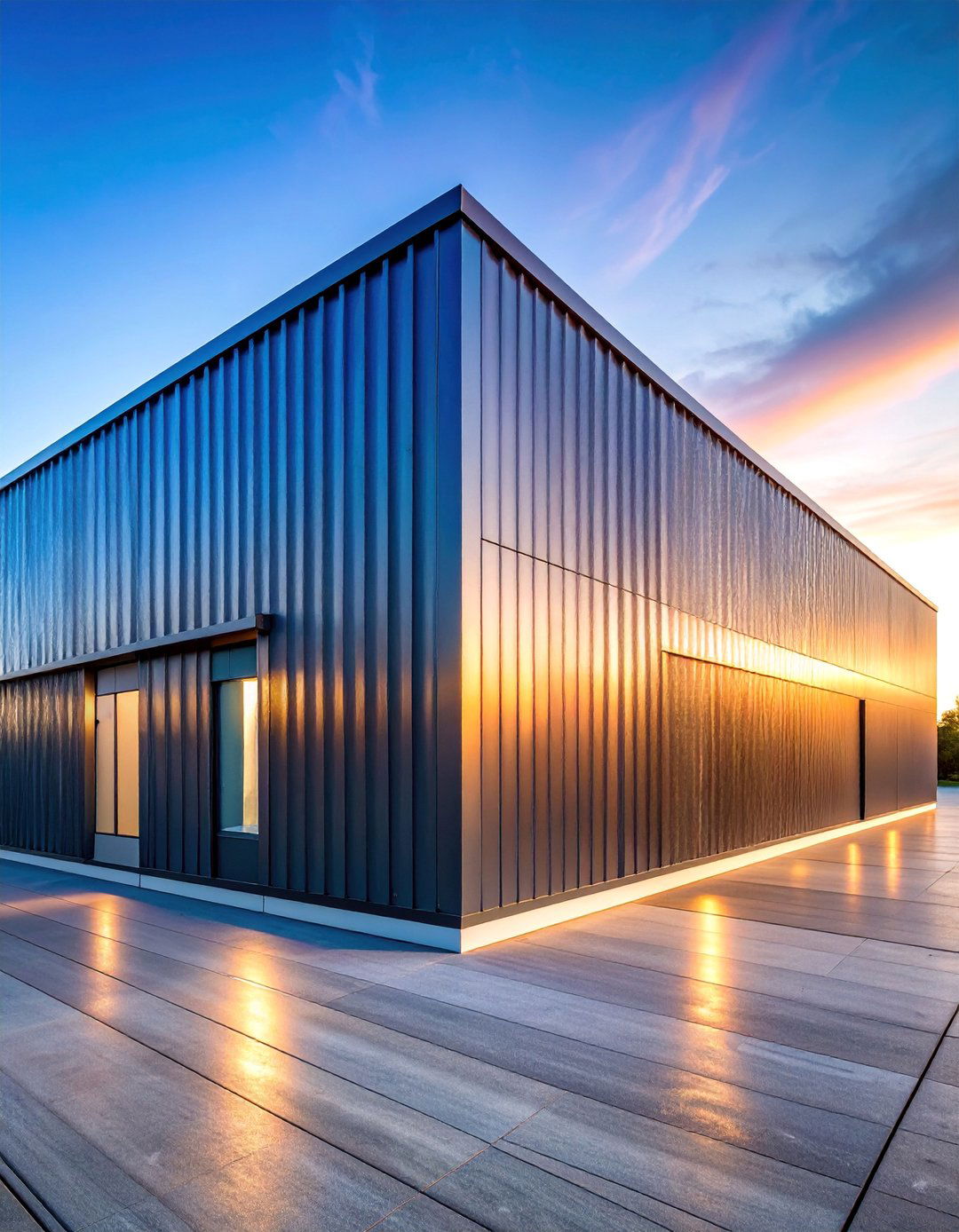
Corrugated metal fascia brings industrial character and modern edge to contemporary deck designs. This approach uses galvanized or painted corrugated panels that provide weather resistance while adding textural interest through the characteristic ridged pattern. The corrugated profile sheds water effectively while creating shadow lines that enhance dimensional appearance. Choose from galvanized finishes for authentic industrial character or powder-coated colors for coordinated design integration. The lightweight material installs easily with standard fasteners while providing excellent durability and minimal maintenance requirements. This style works particularly well with modern and industrial architectural approaches that emphasize clean lines and honest materials. Professional installation ensures proper overlap patterns and secure fastening for optimal weather resistance.
23. Lattice Panel Fascia with Climbing Plant Support

Lattice panel fascia combines traditional styling with garden integration by providing support structure for climbing plants and vines. This approach uses wood or PVC lattice panels that create classic diamond or square patterns while offering attachment points for plant growth. The lattice design provides partial screening while maintaining air circulation and visual interest through the geometric patterns. Choose materials that coordinate with your deck's overall color scheme while providing adequate durability for plant support applications. The climbing plant integration softens hard deck edges while adding seasonal color and natural beauty. Proper plant selection ensures appropriate growth habits and maintenance requirements that complement your deck's intended use and care schedule.
24. Tiered Fascia with Integrated Bench Seating
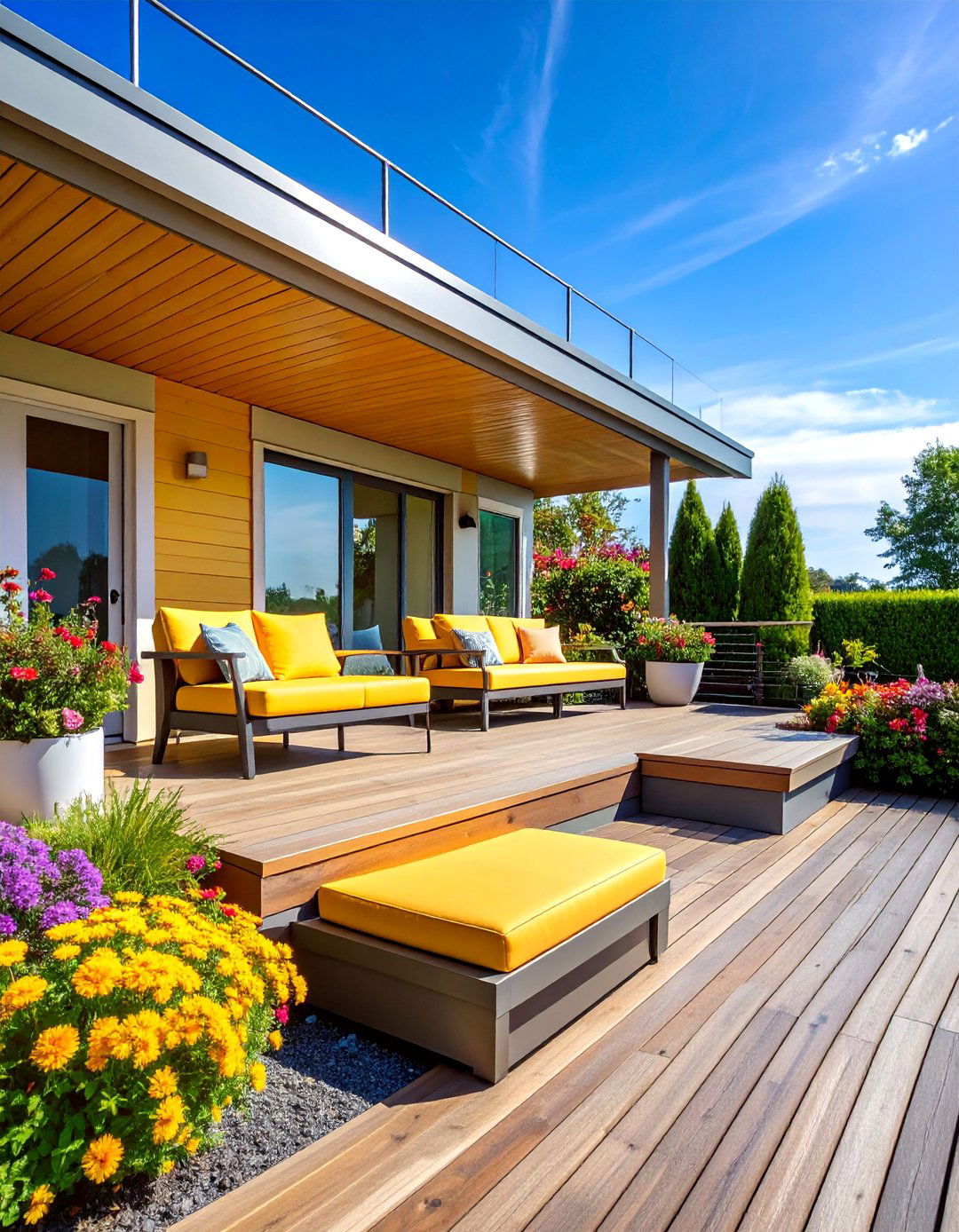
Tiered fascia incorporates built-in bench seating that extends the fascia structure to create additional seating capacity while maintaining clean design lines. This approach builds stepped fascia sections that include horizontal surfaces suitable for seating, with appropriate depth and height for comfortable use. The integrated benches can include back support, storage underneath, or cushion attachments depending on your comfort and functionality preferences. Choose materials that coordinate with your deck surface while providing appropriate texture and temperature characteristics for direct contact. The tiered design adds architectural interest while maximizing your deck's functional capacity. Professional design ensures proper proportions and structural support for safe, comfortable seating that enhances your outdoor entertaining capabilities.
25. Custom Logo or Pattern Inlay Fascia

Custom logo or pattern inlay fascia creates personalized design elements that reflect your family name, business brand, or artistic preferences. This sophisticated approach incorporates different materials or colors to create inlaid designs within the fascia structure. The inlays can range from simple geometric patterns to complex logos or artistic motifs that serve as focal points and conversation starters. Precise cutting and installation techniques ensure clean lines and professional appearance that withstand weather exposure while maintaining visual impact. Choose contrasting materials that provide adequate visibility while coordinating with your overall design palette. Professional design and installation ensure proper scale, proportion, and execution that creates lasting artistic elements worthy of your investment in custom outdoor living spaces.
Conclusion:
Deck fascia represents a crucial design opportunity that transforms basic deck structures into sophisticated outdoor living spaces. From traditional wood applications to innovative integrated features, the right fascia choice enhances both aesthetic appeal and functional performance. Whether you prefer natural materials like cedar and stone or modern composites and metals, careful planning ensures your fascia design complements your home's architecture while providing lasting value. Consider maintenance requirements, climate factors, and personal style preferences when selecting your ideal fascia approach for maximum satisfaction and long-term enjoyment of your enhanced outdoor space.



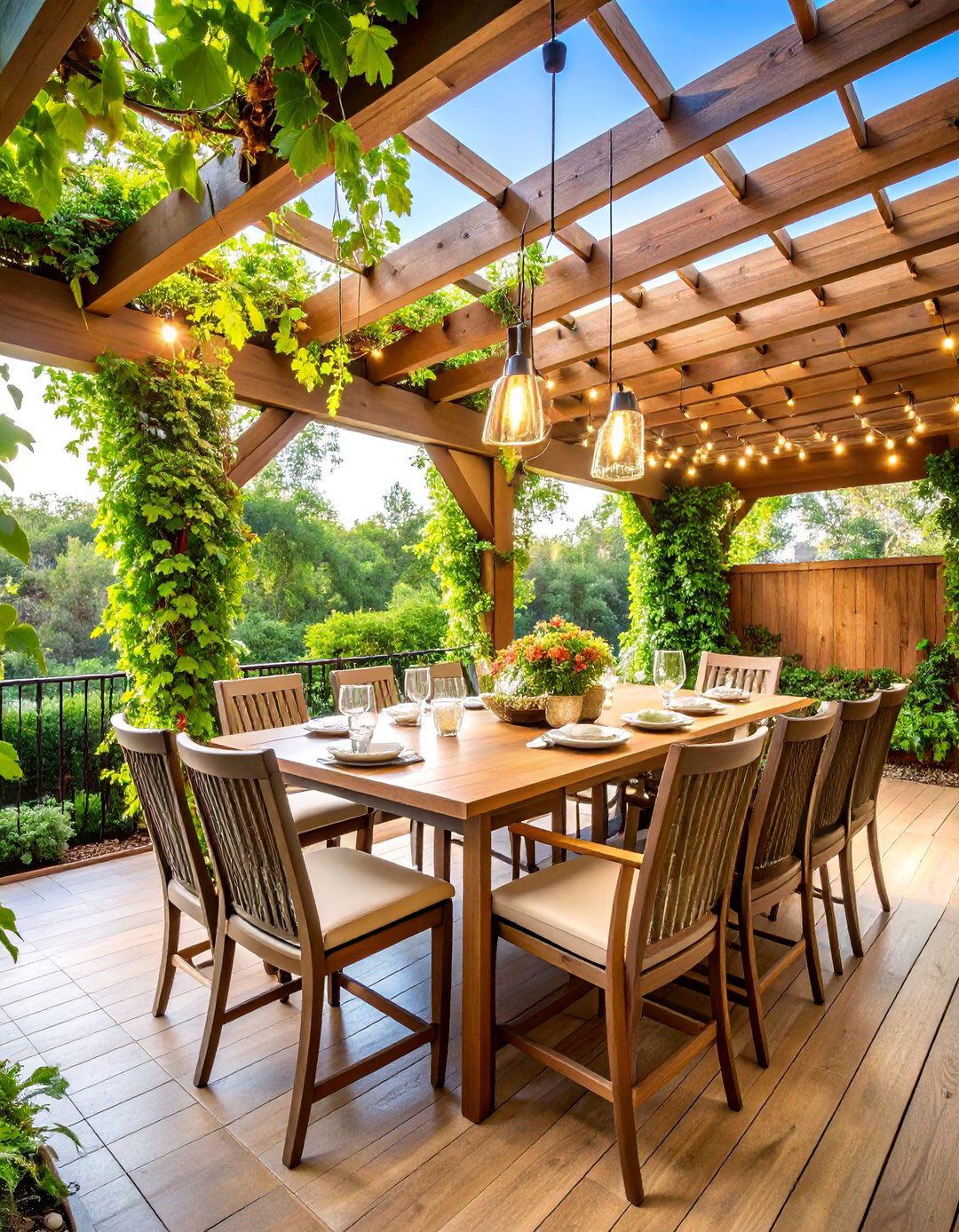
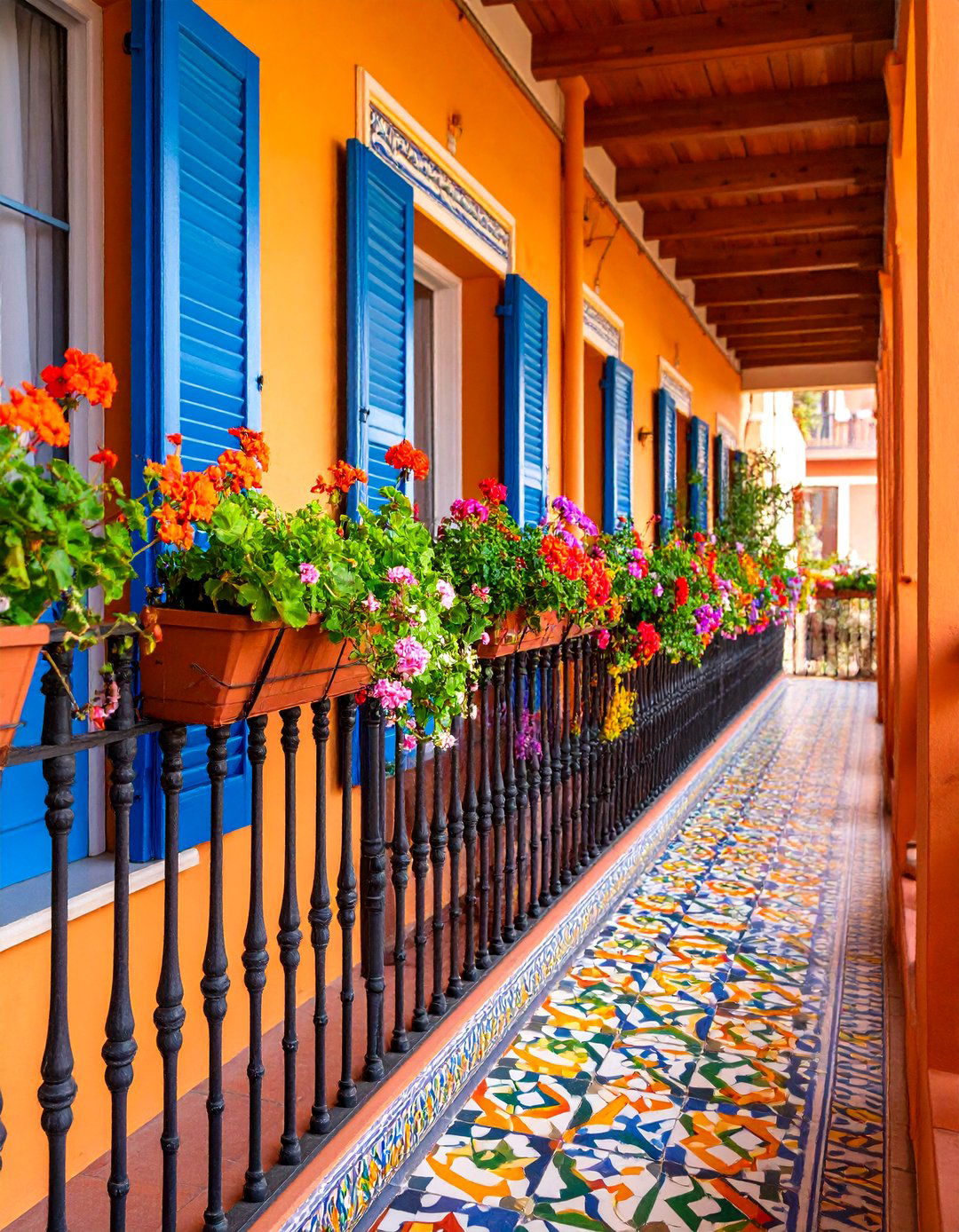
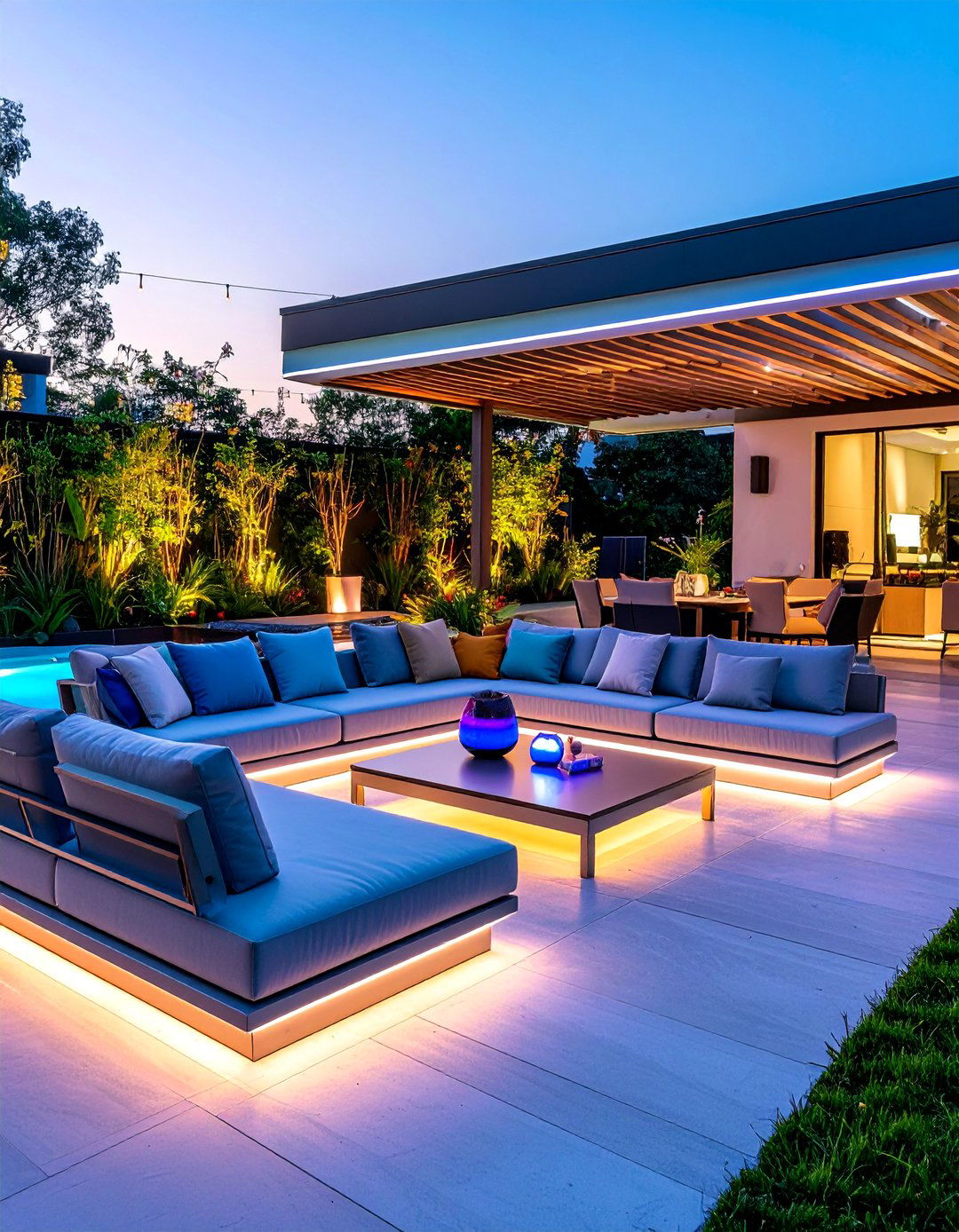

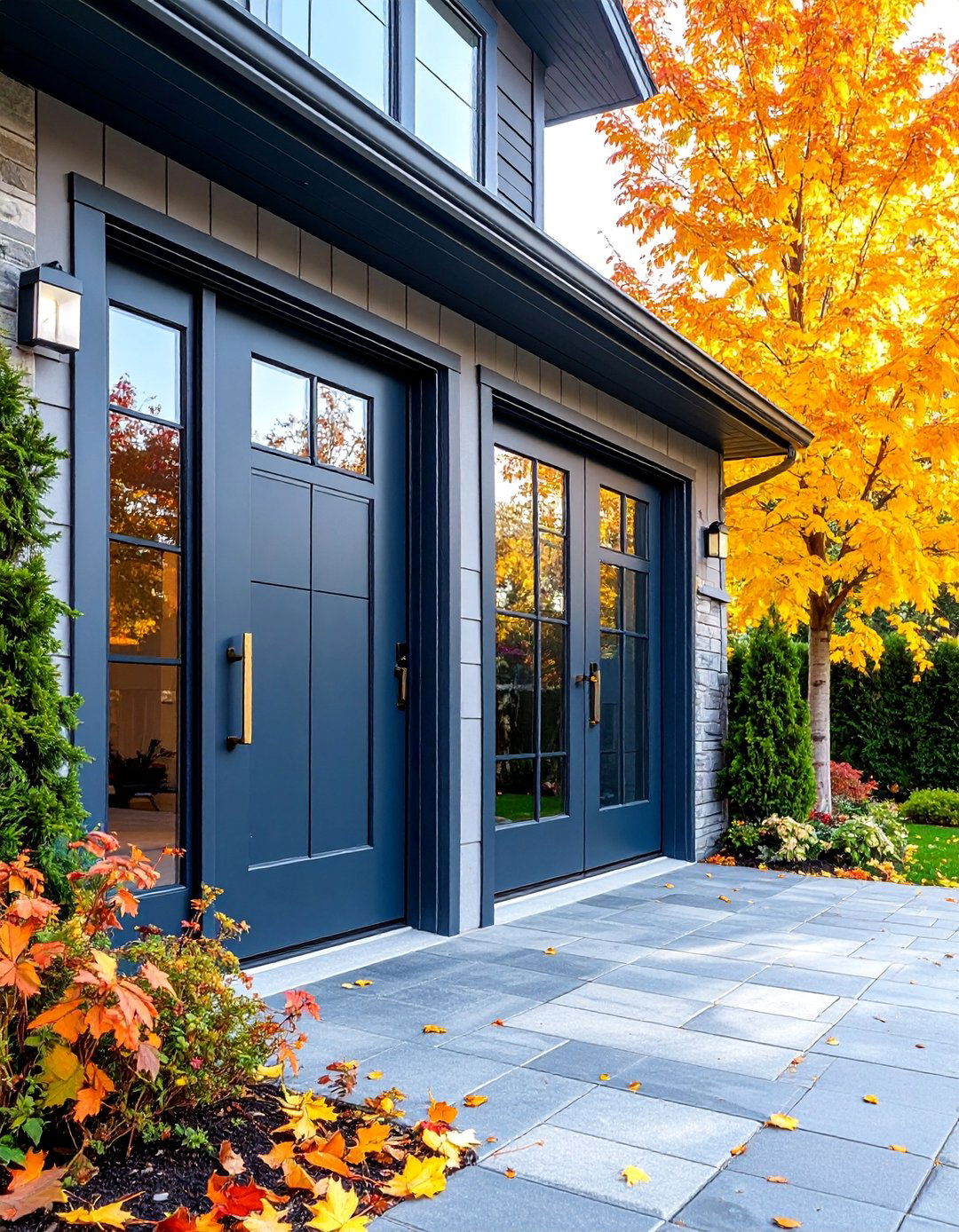
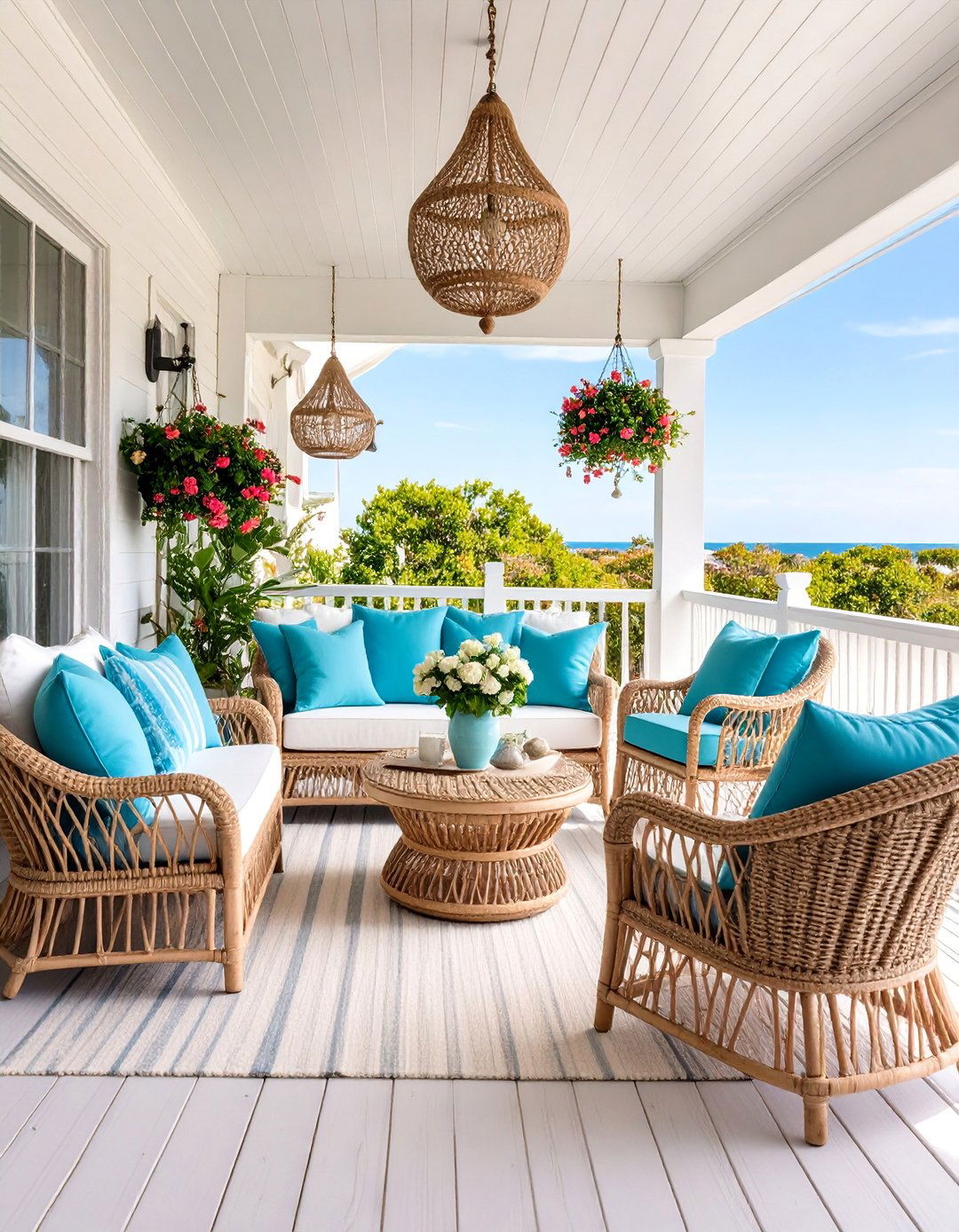
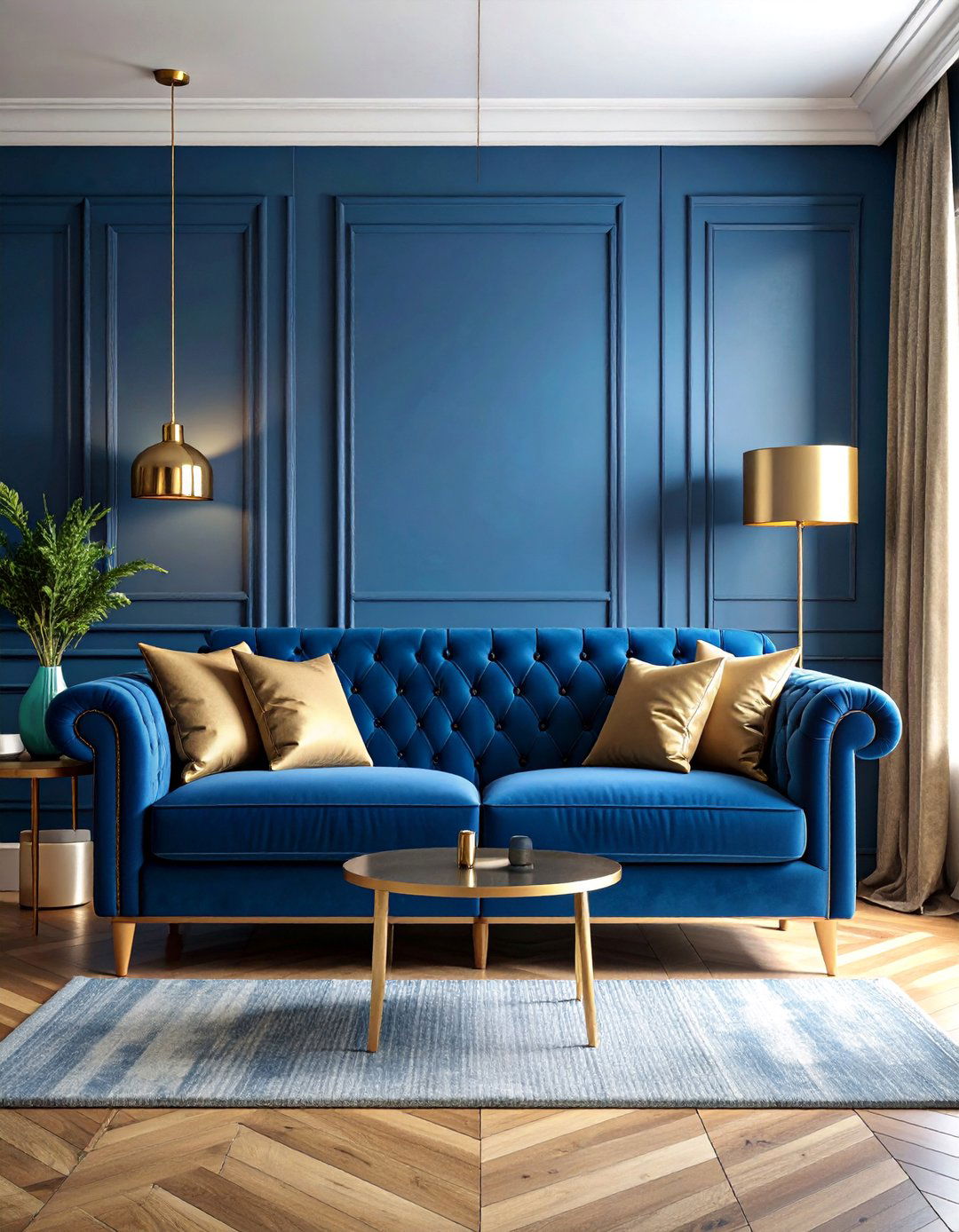

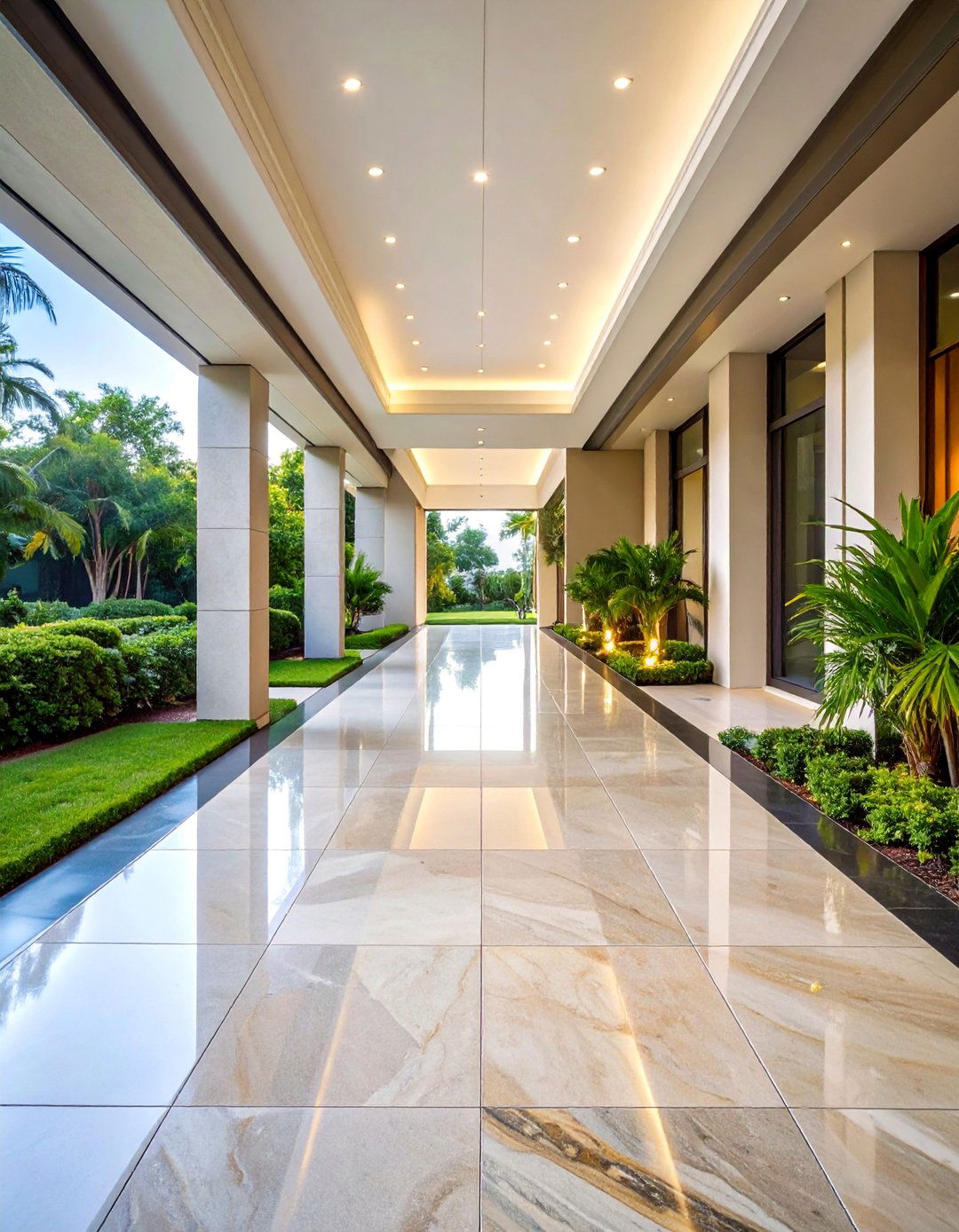
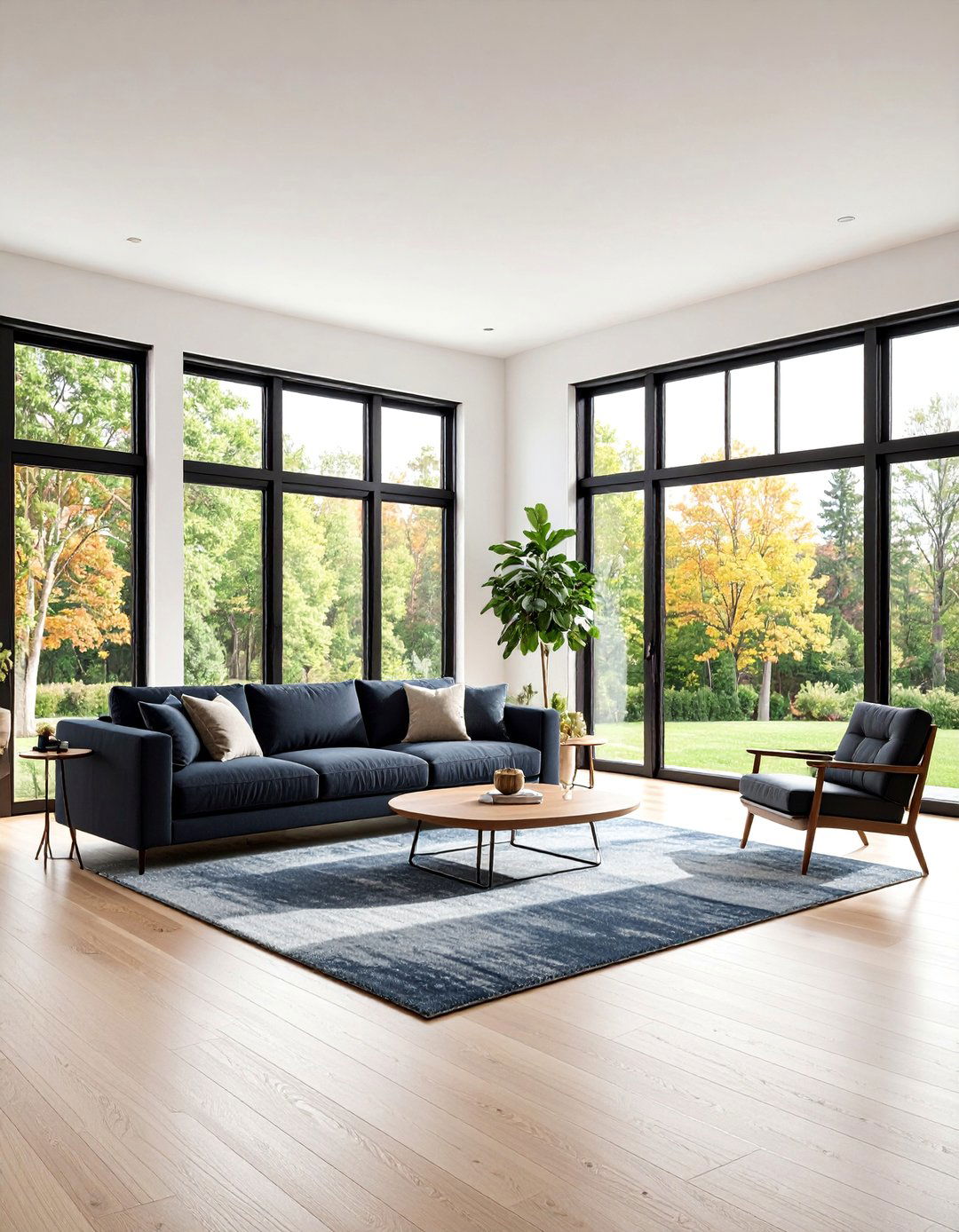

Leave a Reply